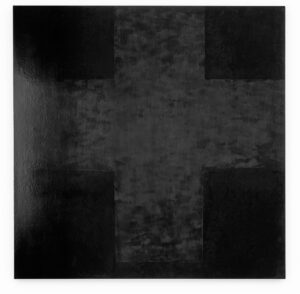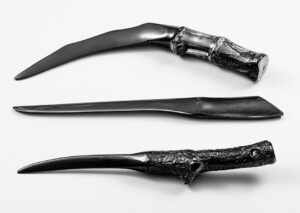Panel Discussion

Comments on the Jurors’ Special Prize Winner s(1/3)
TAMAYA (MC) ───── Thank you. We would like to move to the Jurors’ Special Prize Winners. First, Professor OHNISHI will make some comments on Heri GAHBLER’s “Subtile”.

大西 長利 賞
Subtile
W57 × D1.5 × H57
2018
GAHBLER, Heri (Germany)
OHNISHI ───── Mr Heri GAHBLER from Germany has been submitting his works to the Ishikawa International Urushi Exhibition since it started 34 years ago. I have known him well for a long time. A while ago, I visited the Museum of Lacquer Art Münster, a lovely museum of lacquer. My work was being shown as part of an exhibition there at the time, and I met Mr GAHBLER there where we had the opportunity to talk about a lot of things. We have been friends for over 30 years and for every Ishikawa International Urushi Exhibition he came to Japan from Germany. I feel that he has been delving deeper and deeper into Japanese culture and I always find joy in his discoveries.
When painting lacquer, if you mix pigments into it, it will become stained with the lacquer color. As a result, the color becomes dull and uncertain, but the beauty of lacquer is that it hides this. Just like hiding something important in your pocket, you hide it behind a coating of lacquer. If you apply the paint as is, it will be almost the primary color. That doesn’t make it picture-perfect. But that’s how paint shops make their products. On the other hand, artists try to make their oil paints less like primary colors. I think this is an interesting point that the depth of the paint shines through. Everyone has painted when they were children, when vivid colors were appealing, but at the same time somber and deep colors, such as when fish could be seen swimming in a dark river were also interesting. But these days, on TV it’s easy to see anywhere, even in the ocean, so it’s no longer an issue.
In short, the charm of urushi is its visible yet invisible nature. Subdued colors are valued, and over-bright and shiny colors are not. In the case of atmosphere, particularly at night, lanterns and candles give you dim light. That dim light is important. The charm of urushi cannot be expressed by anything else. GAHBLER knows this particular point and takes it very seriously. His submission this year is a deep green work that is barely perceptible. Painting an image with urushi is an important task. Oil paints cannot express the world of this artist. Oil paintings can express bright primary colors but not the deep and subdued colors. That’s why I’m looking forward to seeing GAHBLER here again in the future.
TAMAYA(MC) ───── Thank you. We will move to the Motomi Kawakami Prize winner, “Forest Children-Envelope Opening Knife” by Fumio ENOMOTO.

川上 元美 賞
森のこどもたち -封書開きナイフ
Forest Children
-Envelope Opening Knife-
W26 × D24× H4
2019
榎本 文夫
ENOMOTO, Fumio (Japan)
KAWAKAMI ───── I was a little unsure about which work to select as my special prize winner, but in the end I chose “Forest Children-Envelope Opening Knife.” Japan’s forestry industry is in a state of exhaustion, but to put it bluntly, if the forests that have been planted are not thinned, they will weaken their environment. If we don’t take care of the forests, they might cause landslides and eventually collapse. In such circumstances, the artist can utilize the material of the forest. When we use wood as a construction material, chemical material, or for wood turning, depending on the part of the tree, we classify it as special grade, first-class, sawn wood, etc. It is ranked in various ways, such as whether it is smooth or has knots. In such a situation, there is always a lot of leftovers. As it stands now, the price is really low, and it ends up being used for things like paper, pulp, and biomass chips.
People who work with wood feel the pain of such things, but this artist takes advantage of the natural shape of the wood scraps, finishes them with kuro-nuri (black lacquer) and tame-nuri (transparent lacquer). By utilizing the strength of dry urushi, the artist hit on the idea to make paper knives, tools for opening envelopes. It is an interesting idea that is different from what is usually made with lacquer. The title is ‘Forest Children’ which shows the artist’s compassion for the wood.
Now, society is moving toward sustainable development and a circular society. People already know that our everyday lives will become very difficult unless we make efforts for an environmentally-friendly lifestyle. Thus, this work shows off the artist’s attitude toward Sustainable Development Goals, which is wonderful to relate to urushi. I feel the depth and strength of the urushi, so I selected this work.
This work was submitted in the Art Category. At the Final Assessment, all the jurors discussed the boundaries of the Art and Design Categories. This is deep issue. Just recently, in Osaka, there was an exhibition with the theme ‘Art in Love with Design – Design Envious of Art’. This was a collection of various design and art works from postwar Japan, and it was an exhibition to evaluate them. I think this was an exhibition for people to see and think about the overlap between them. There are similar issues faced by urushi, but the evaluation made me realize that the way we think about it from various angles is deepening, and the boundaries are expanding more and more.
